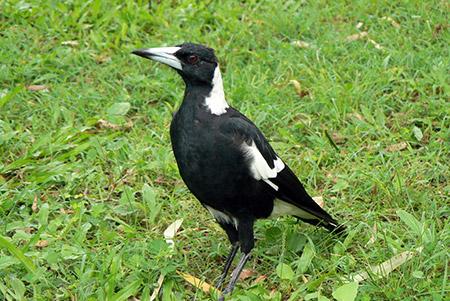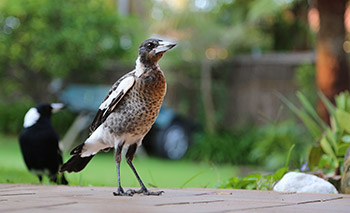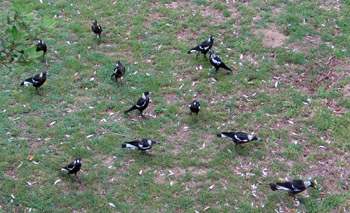Birds
Magpie Removal & Management
Australian Magpie
Gymnorhina tibicen
Other Common names: Magpie
Physical description:
- Large and familiar black and white bird reaching an average size of 36-44cm in length.
- Dagger-like pointed beak coloured blue-grey with a black tip.
- Slight differences between the sexes, with female’s white regions a mottled dusky grey. Juveniles are alike females with greyer black areas.
Ecology
- Inhabits a wide range of habitats, preferably those with open grassy areas surrounded by trees. Vegetation types include open woodlands and forests, scrubland, farmland and suburban areas
- Magpies are omnivorous and efficient generalists, primarily foraging on the ground but will sometimes retreat up into the tree canopy to eat if other birds are around.
- Their diet has been recorded to consist of over 140 different food items, which includes invertebrates, plant matter, reptiles, amphibians and small mammals. Scavenging off carcasses is not uncommon.
Breeding
- Magpies like some other birds have an extended breeding season, with nest building, incubation, rearing of chicks and fledging occurring between June and December.
- Females build the nests high up in the tree canopy, but will sometimes utilise saplings and bushes where tall tress are absent.
- Dry sticks are used to make a ‘bowl’ which is lined with soft materials such as grass, bark and other plant material.
- In suburban areas the outer layer of the nest may incorporate wire, fabric, plastic, rope, binder’s twine and clothes pegs.
- Clutch size can vary accordingly to factors such as season, weather, health of the animals and predator presence. Usual clutch size is 3-4 eggs, each of which is approximately 38mm x 27mm and oval in shape. Incubation lasts 20 days.
- Newly hatched chicks are at first pink, naked and blind, having large feet and long necks with broad beaks. Feathers begin appearing within a week and after approximately one month have a full set of feathers and are ready to fly.
- Studies show that that the survival rate for chicks is only 14 percent under good conditions, with young falling prey to goannas, snakes, birds of prey and domestic pets.

Juvenile Magpie
Suburban Magpies:
- Magpies have become successful in suburban areas where land clearing and construction have modified once tree dominated landscapes into open spaces allowing for an increase in foraging opportunities.
- Other activities that contribute to magpie occupation include feeding by residents, feeding domestic pets outside and leaving rubbish out for magpies to scavenge through.
- Magpies are very territorial, and will defend their nests against anything from other birds, predators and even humans.
- Attacks on people occur as magpies cannot distinguish humans from other animals, they see us as just another intruder or possible predator and so swoop at us to try to scare us away.
- Some birds are overtly aggressive and it is these birds that are the most cause for concern, as they can often cause serious injury to humans.

A congregation of Magpies
Living with Magpies
A swooping magpie can be an intimidating and potentially dangerous scenario. The degree of intensity exhibited by each attack may vary from bird to bird with the usual assault being from behind and to the head. Some attacks although rare can occur from the front in the case of particularly aggressive birds. It should be noted that statistically only 3% of the entire population of magpies exhibit swooping with contact as a defensive behaviour.
So what can you do to try and deter an swooping Magpie in your yard before opting for magpie removal?
- Magpies are a protected species under Australian law and attempts to harm or kill these birds are illegal. These birds are merely protecting there young from a perceived intruder in much the same we would our own children.
- Don’t feed magpies. It is commonly believed that by feeding these birds they become friendly and won’t become a nuisance. The truth is it encourages other animals into the area to take advantage of a free feed.
- Avoid the area. If there is an alternate way of getting to work, going to the shops or taking the kids to school then use it instead. It’s a small price to pay when considering a potential injury.
- Where possible keep your eye on the bird. In most cases the bird will not swoop and make contact if it sees you are watching. If the bird does approach the simple waving of an arm will deter it from making physical contact.
- Carrying a hat, umbrella or alternate object which you can hold above you head can help in deterring birds from swooping. Walking in a group can also be a great tactic.
- Placing eye spots on your bike helmet, wearing sunglasses on the back of your head or keeping the bird in eye contact may in some cases help prevent swooping. Magpies utilise the element of a surprise attack when you’re not looking. Therefore maintaining eye contact, or the illusion that you are, may as previously mentioned aid in deterring them.
- Don’t harass the birds, as this can make them more aggressive and more likely to injury someone else.
- Informing your local council and having them erect signs is a great way of informing residents of swooping birds in the area so they are aware of the temporary risk.
Magpie removal, Advice & Relocation
If your best efforts of deterring the bird fail then magpie removal may be your last resort. Ecologically-minded magpie advice, specialist trapping requirements, and ecologically sound magpie removal methods are employed by licensed professionals for effective magpie removal.
Trapping & relocation of the birds is done in accordance with requirements stipulated by the Environmental Protection Agency and permits are issued after stringent examination as to knowledge and suitability to actively manage conflict magpies.
Every effort is made to ensure the birds are managed as to welfare, and to minimize any possible harm whilst being trapped, upon trapping, and through transit to a suitable release site.
Magpie removal contacts for Brisbane, Gold coast and surrounding areas can be reached for the following areas:
Brisbane West including The Gap, Bardon, Chapel Hill, Kenmore, Brookfield, Sinnamon Park Oxley, Algester, Forestdale and surrounding suburbs
0413 028 081
Ipswich and surrounding suburbs
0413 028 081
Brisbane North, including Moreton Bay Regional council areas south of Caboolture
0413 028 081
Brisbane South including Moorooka, Yeronga, Woolloongabba, Wynnum, Cleveland, Carindale, Holland Park, Marsden
0421 455 077
Gold Coast all suburbs
0418 738 228
